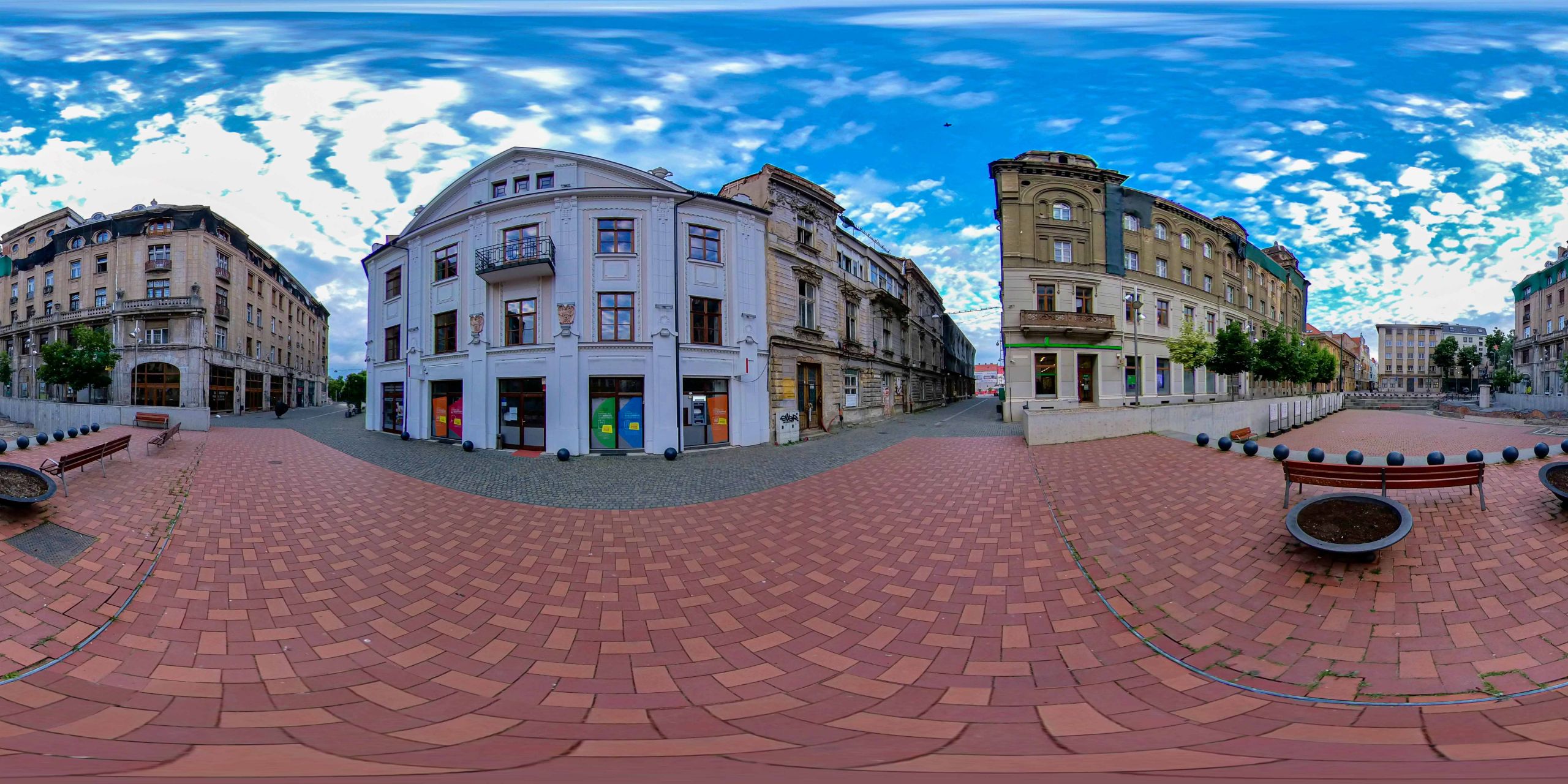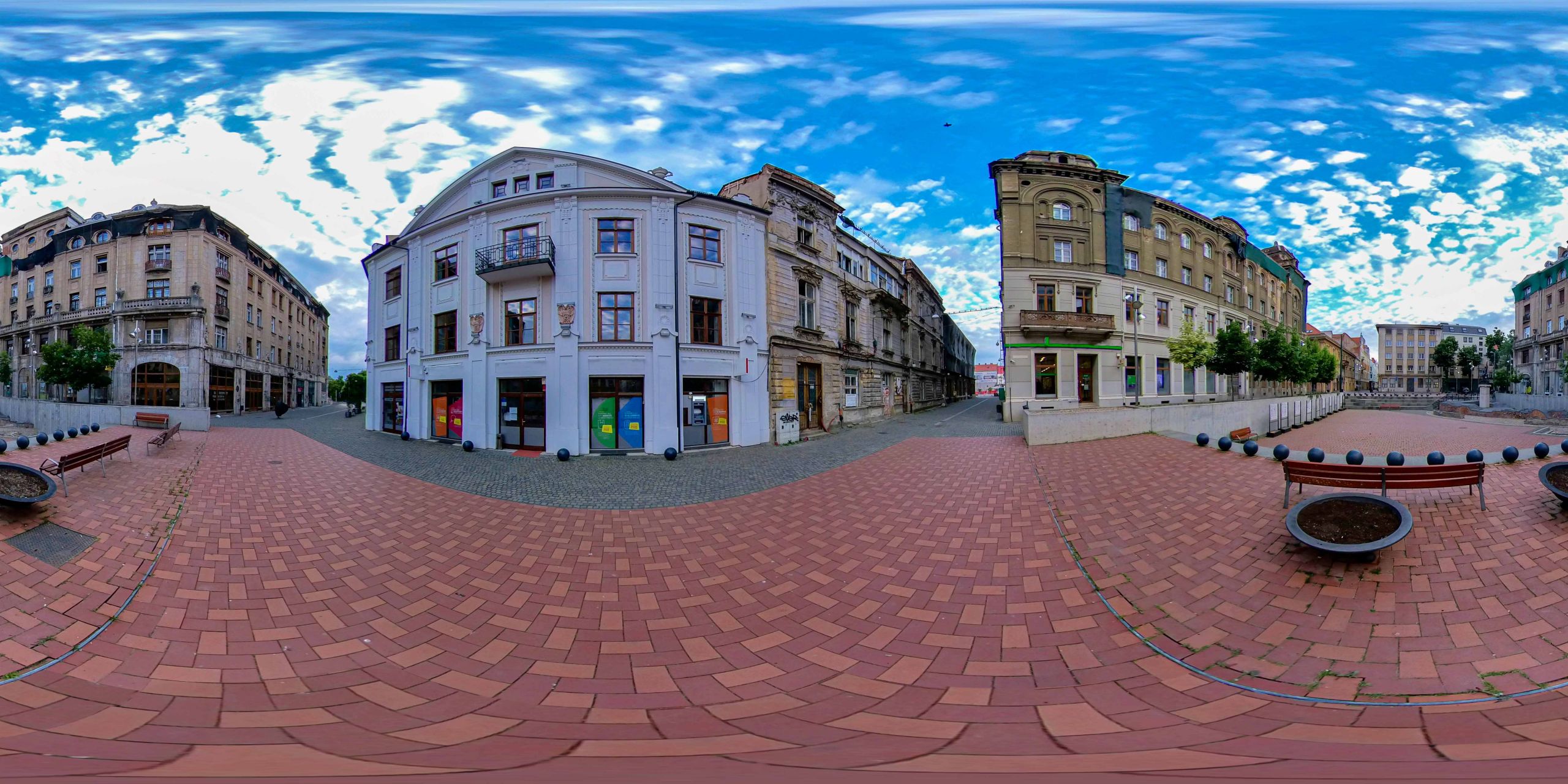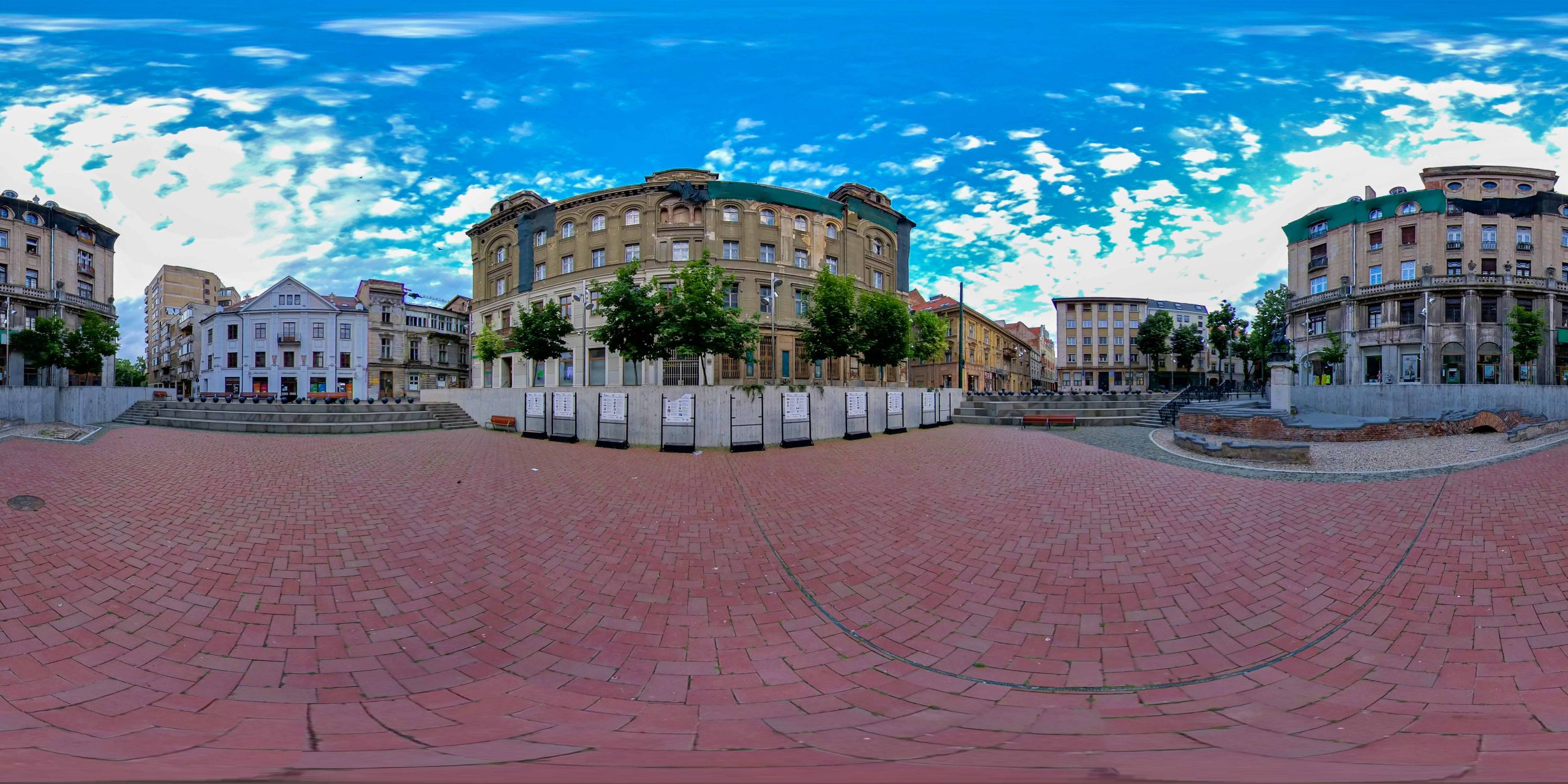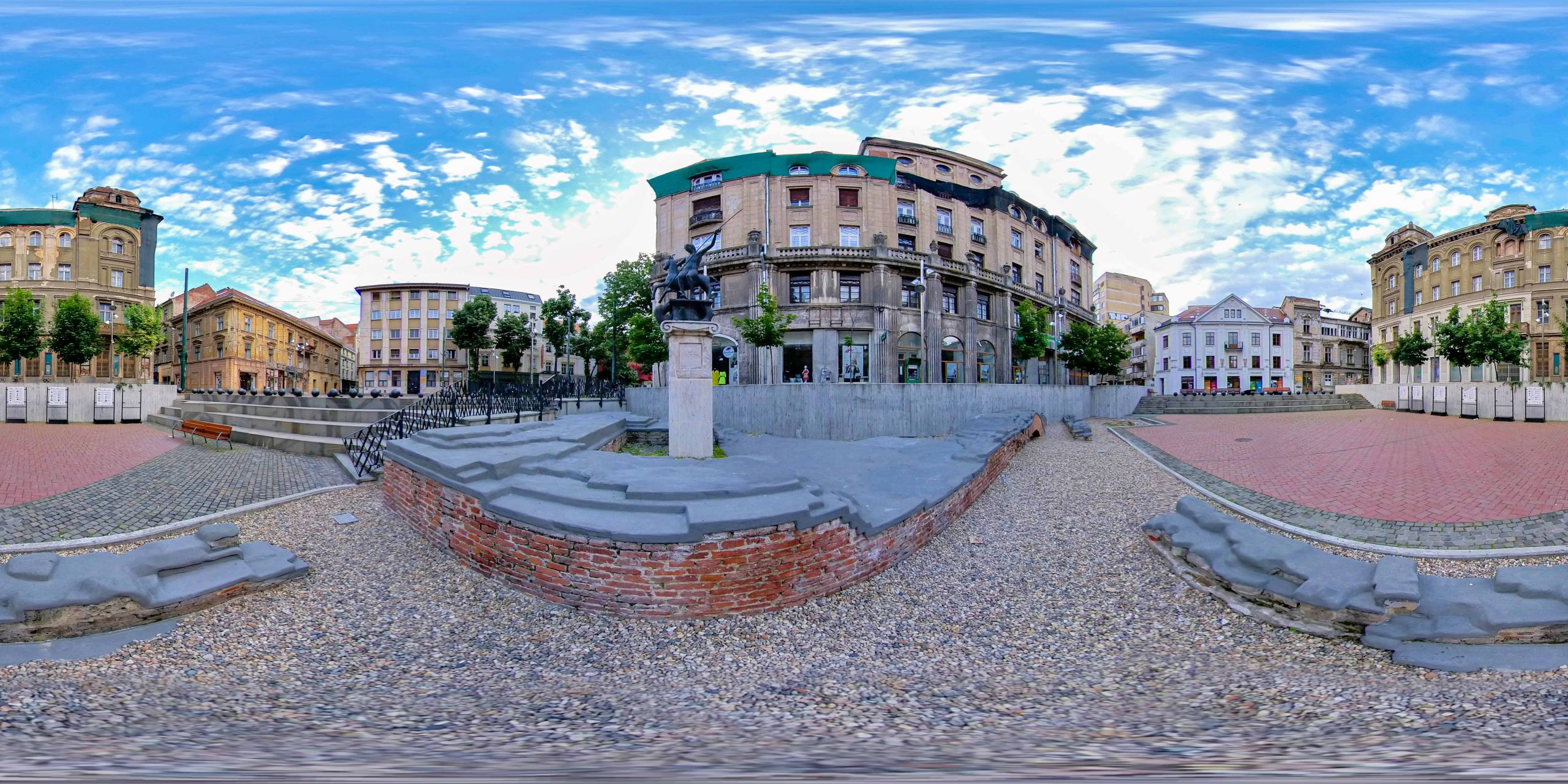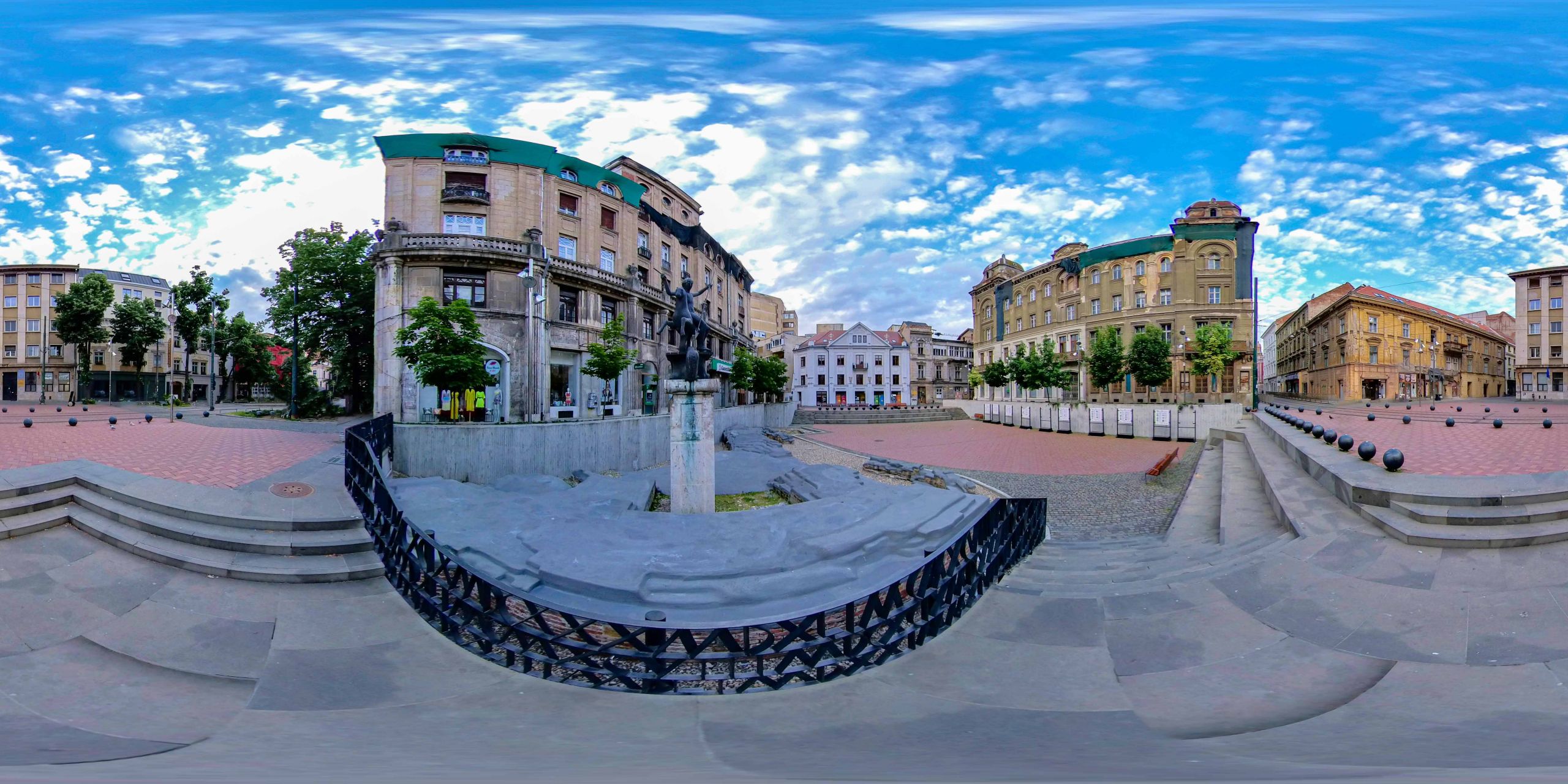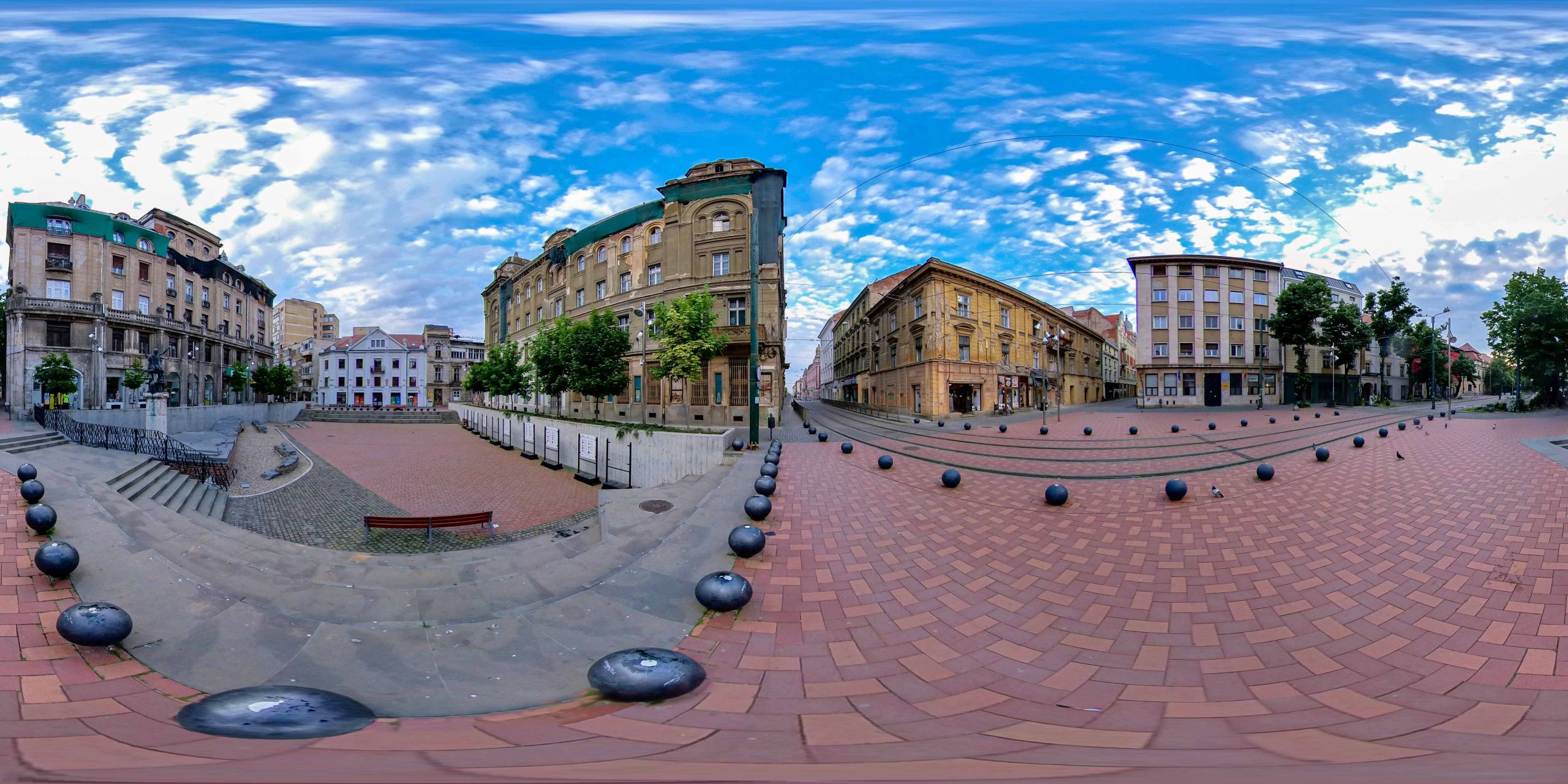St. George’s Square is one of the oldest squares of Timişoara. Until 1914 the square was dominated by the "Jesuit church" or "seminary church", which was dedicated to St. George.
Listen to the audio version.
St. George’s Square is one of the oldest squares of Timişoara. Until 1914 the square was dominated by the "Jesuit church" or "seminary church", which was dedicated to St. George. The building of the Casa Bănățeană Society (Banca Szana) was built on this site, according to the project of the architect Ernest Theodor Foerk, with the building permit of October 10, 1914, modified after the First World War by the architect Josef Kremmer Junior, with a new building permit of 1 October 1921, in the style of the 1900s eclectic. On the west side of the square is the First House of Savings in Timișoara (Erste Temeswarer Sparkassa), built-in 1855 according to the plans of the architect Karl May in an eclectic historical style, remodeled between 1912-1913 according to the project of the architect László Székely. On the south side of the square, next to the blocks of flats built during the socialist period, is the house "La leu" (str. Enrico Caruso no. 3), next to the house and studio of the famous photographer József Kossak (str. General Praporgescu no. 2). On the north side of the square, there is the house called "La vulturul negru" (Florimund de Mercy street no. 2), in eclectic historical style, demolished and replaced by the Albina Bank building in modern interwar style, built according to the plans of the architect Silvestru Rafiroiu and architect Constantin Purcariu, with the building permit from 1939. In 1996, the equestrian statue of Saint George fighting the dragon was placed in the square, a commemorative sculpture for the events of December 1989, a bronze creation by the artist Silvia Radu, on a pedestal made by Ştefan Călărăşanu. In St. George’s Square, the first station for the horse-drawn tram was put into operation in July 1869, the end of the line for the tram that connected with the Fabric neighbourhood.
Bibliography:
- Mihai Opriș, Mihai Botescu - Historical Architecture in Timișoara, Tempus Publishing House, Timișoara, 2014
- Josef Geml, The old Timișoara in the last half of the century 1870-1920, Cosmopolitan Art Publishing House, Timișoara, 2016.
St. George's Square
Robert Șerban
the dragon looks like a pregnant puss
that swallowed a bat
and woke up with wings
the kids give him their sandwiches
and water in biodegradable cups
and those named
georgie geordie or george
pat him on the head
and would like to take him home
for good
June 2022
“On Mercy Street, named after the city manager following the conquest of Timișoara by Eugene of Savoy, there was the workshop of Mr. Holzner - shoemaker. Mr. Holzner, cripple from the hip and man of honour. About opposite his shop window, on the other side of the narrow street, through a door in the wall that may never have existed, I went inside the police headquarters as a witness; I was, say, ten years old. Down the street, around the corner, there was Mr. Martin, from Orșova - butcher. White tiles, pig halves, dripping blood. You crossed Savoy Street and, at the other corner, in the '50s, with my mother - striped pajamas. And so on, other streets up to Hector Street, whose history, which I have just found out, makes me laugh. Poor Hector, the kindest man, dragged along the wall, bearing a dog’s name. Grivei Street. St. George’s Square was jostling in front of the tram line with “Globul” bookstore at one end, and, at the other, on the side, with Tungsram bulbs, in red capital letters. I’ll stop here. There are also some other places. Pallas, Kütl Square, Domnița Hélène railway station.” (Livius Ciocârlie, The Sunken Bell, Cartea Românească, 1988, p. 173-174)
In Sfântu' Gheorghe square, where I lived, there were plenty of very famous shops. Near the corner, there was a very beautiful and elegant jewel, there were shoes, then there was Banca Szana and on the corner we had "Babcsány". "Babcsány" was a delicatessen shop. Formidable! I didn't really go there, because it was too expensive, but, for example, in the winter there was a boar or two kept outside, for sale; rabbits were hanging, so, basically, they had all the delicacies in the world. And there was also a very fine delicatessen shop, but not as expensive as "Babcsány", on that narrow street that leads from Sfântu’ Gheorghe Square to Libertăţii Square, where the Moravetz bookstore was. And near Moravetz there was a delicatessen shop that brought smoked fish and sardines and the first figs and the first tangerines…in winter, from Germany. And everything, in the old days, was related to the season! Now only Romania and Europe kept things still a little seasonal. But otherwise, nothing!
So there was a very interesting shop there. Moravetz was a very good bookstore too, which brought everything that appeared in German language, across Germany and Austria, English books. For example, from Pinguin Library, published cheaper in England, but excellent, I still have them, written, edited by me, in 32..
Mariana Sora (b. Klein, 1917) interviewed by Smaranda Vultur at Băile Herculane in 2001. Third Europe Archive, BCUT.
Then there were restaurants and "colonial and delicatessen" shops. It was a very good store, which I see that Mrs. Mariana Şora also remembers in her memoirs, I was startled with pleasure when I found it there, because I also remember it, especially in an olfactory key, because you would enter it and some extraordinary smells would envelope you. It was called "Babcsány" and it was right on the corner, on the ground floor of the building in Piaţa Sf. Gheorghe, where the "Orizont" newsroom is today. The last time I was in Timișoara, I saw that a new pharmacy was built there.
Radu Ciobanu (born 1935), interviewed by Simona Adam in 2002 in Deva. Third Europe Archive, BCUT.
( ...) And the war broke out. My father had just completed his military service in the artillery, at the Artillery School in Timisoara. My father was also mobilized and spent four years and four months under arms on all Austro-Hungarian fronts.
(What was his name?) Rudolf Klein. And this Rudolf Klein, when he graduated from the Commercial High School in Timişoara - it was a Trade School in Timişoara, of course with Hungarian and German as the teaching languages - he only spoke German with his mother. He became a clerk at the Bank of Timișoara, which belonged to one called Szana, a wealthy Jew - it was a private bank. Marmoroş Blank also had some shares there, so it was a solid bank. Young Klein, when he entered there had the post secured, according to the Austro-Hungarian laws, until he came back from the war.
Meanwhile, in 1916, before Romania entered the war, there were rumors of peace, rumors of an armistice. And he came on a vacation to Budapest. These "famous" Rudolf and Elsa, my parents, had already met in Timișoara and were kind of flirting with each other. And then he went to see her in Budapest. And, because there were rumors of peace, they got married. And so I was born, a year later, in 1917, in Budapest, my father being again, somewhere on the front.
My mother, my grandmother and I stayed in Budapest until the spring of 1919, when we returned to Timișoara and my father was able to resume his job at the bank. (When was the bank abolished?) The bank was abolished... as early as ‘40, because we’re talking about Jewish wealth. Szana died and the bank was taken over by Marmoroş Blank from Bucharest and, as Marmoroş Blank was a Jewish bank, it was dissolved and my father was left on the streets. Later, during the time of the communists, he was rehired at the National Bank - where he had been director of over three sections, now he was hired as a small clerk… and left with a miserable pension.
(...) When I was five years old, the first four-story house was built in Timișoara. It was the bank building and it was called Casa Banatului. And down there it said "The Bank of Timișoara". On the side, on the small street - our address was still Piaţa Sfântu' Gheorghe, number three - the gate was there. On the fourth floor, where the rooms were a little lower, as they are now, there were apartments for bank officials, which were not free, but they were a little cheaper. When I was five we moved out. (And where was the bank of Timişoara before?) ity Hall Square, that is Libertăţii, at one end there was the Town Hall, at the other end was the Market Square. And, near Comenduirea Pieţii, where all the officers lived, a little closer when facing Libertăţii Square - the last house on the square - where I used to go to my father's office to visit and also where I saw a telephone for the first time. There was a phone hanging on the wall and I wasn't tall enough to reach it, so my father would give it to me and I would shout: "Hello, hello!"
Later, when this new building was built and my father was the head of two or three sections, he had three telephones on the table and one would call, the other one would call, he was like a modern manager. That's why my dad never allowed us to have phones in the house.
In the Banat House, from the window of my room - one of the windows was kind of a porte-fenetre, like the French have - I could see over all the roofs starting from the Citadel to the Green Forest. And then, I don't know how old I was, ten, maybe twelve, because at thirteen I was no longer there - and I thought about the problems we have today. I said: look, the city stretches out, one more house, one more... and what will happen if people multiply too much and there will be no more fields and cities will start touching other cities... I loved these roofs, I loved the Green Forest which could be seen in the distance.
(...) And at Casa Banatului, in front of the bank's entrance, at one point an electric clock was put up, when we were still living upstairs, so in the 20s. An electric clock was put up and there was the rendez-vous place. There was the entrance to the Bank, and if you went towards the Post Office, towards Fabric, just above the corner, where the building continued, in this narrow street, there was the entrance gate into the house, with an elevator. And, before the gate, there was a small, narrow bookstore, which also had a lending bookstore. German and Hungarian. I used to read there a lot. My mother was a subscriber and got everything that appeared at the time, Erich Maria Remarque and Stefan Zweig and everything new, plus translations from Russian, Dostoevsky... Plus my Karl May that I read at nine, ten, eleven years old, with passion. All these books could be found there, in the German bookstore.
Mariana Sora (b. Klein, 1917) interviewed by Smaranda Vultur at Băile Herculane in 2001. Third Europe Archive, BCUT.
